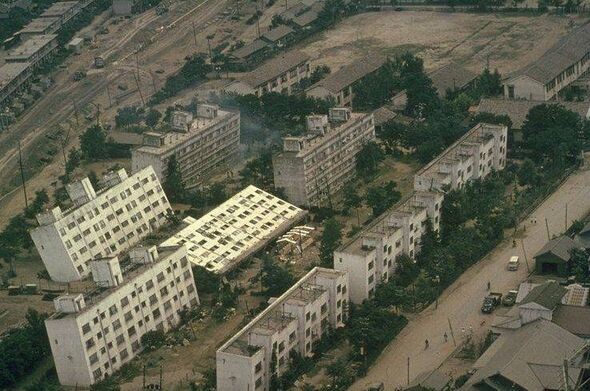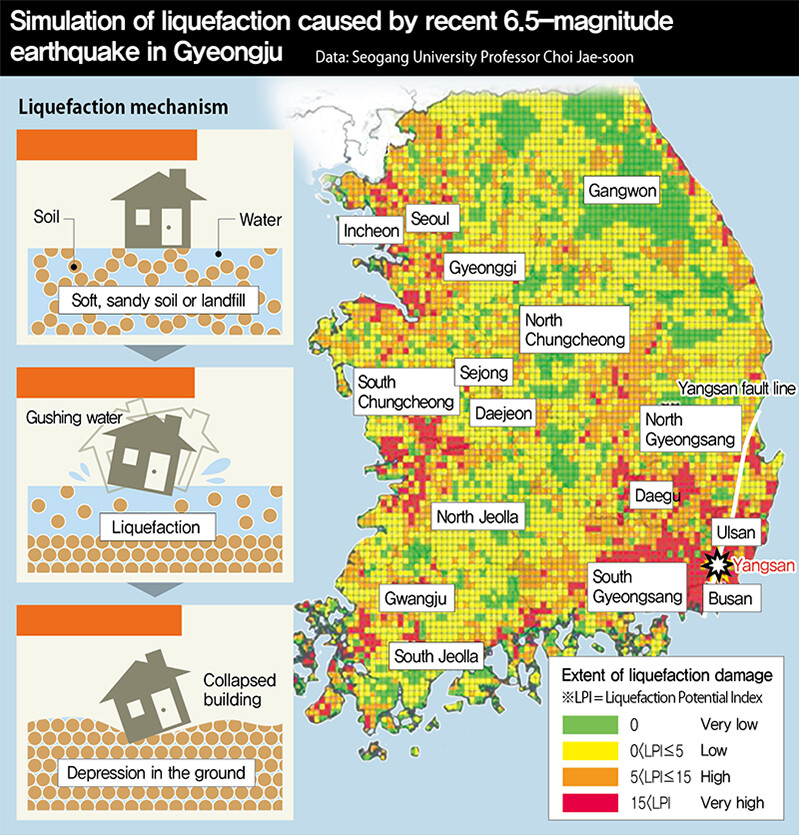hankyoreh
Links to other country sites 다른 나라 사이트 링크
After Gyeongju earthquake, stress tests for nuclear power plants moved up one year

A recent earthquake in Gyeongju has prompted the South Korean government to move up planned stress tests for all nuclear power plants by one year and bolster their earthquake resistance. But no measures have yet been suggested for reducing or closing plants built in earthquake-vulnerable regions like Gyeongju.
The decision by the Ministry of Trade, Industry and Energy to further bolster the “extreme natural disaster countermeasures” pursed in the wake of the 2011 disaster at the Fukushima Nuclear Power Plant came at an earthquake follow-up measures review meeting presided over by the minister on Sept. 18 at the Korea Electric Power Corporation (KEPCO) southern Seoul headquarters in Seoul’s Yeouido neighborhood. As a first step, stress testing of nuclear power generation facilities is to be completed by late 2018. The project had an original completion date planned for late 2019, but was moved up one year in response to growing concerns about power plant safety. First introduced in the European Union after the Fukushima disaster, stress testing involves assessing the soundness of nuclear power plants against natural disasters and other outside influences.

Reinforcement of power plant earthquake-resistance was also scheduled for completion by Apr. 2018. The reinforcement work involves increasing the level of earthquake-resistance for existing plants from quakes at 6.5 on the Richter scale to 7.0.
But reinforcement would not apply to the plants as a whole, but only to systems crucial to their safety, including those related to nuclear reactor reactivity control, reactor coolant pressure and stock control, and residual heat removal. The effort would apply to all 24 reactors currently in operation. Reinforcement efforts have already been completed for reactors at eight plants: Wolseong No. 1, Gori No. 1, and Hanbit Nos. 1 and 6. Earthquake-resistance reinforcement efforts are also planned for radioactive waste disposal sites.
“Earthquake-resistance reinforcement is not enough to guarantee power plant safety,” argued Yang-Lee Won-young, director of the energy and climate team for the Korean Federation for Environmental Movement (KFEM).
Indeed, the upgrade in earthquake-resistance from 6.5 to 7.0 announced by the government would apply only to certain power plant systems rather than the plants as a whole. Even if the design is bolstered to resist earthquakes at 7.0 on the Richter scale, the power plants would still be vulnerable to an earthquake at 7.5, as some experts have argued.
“We need to phase out the twelve reactors in the earthquake risk zone at Wolseong and Gori and refrain from further extending the life of outdated plants,” Yang-Lee said. “Reducing the role of nuclear power in power generation is essential.”
The government and ruling Saenuri Party made plans on Sept. 18 to consider declaring Gyeongju a special disaster area. At a party-government round table on response measures to the Gyeongju earthquake held at the National Assembly that day, Saenuri Party leader Lee Jung-hyun called for “quickly investigating things and declaring a special disaster area as soon as possible if the conditions are met.”
In response, Vice Minister of Public Safety and Security Lee Sung-ho said damages “would have to exceed 7.5 billion won (US$6.7 million)” for Gyeongju to meet the conditions.
“Since there have been secondary damages, we will re-investigate things promptly and consider a special disaster area declaration if the conditions are met,” Lee added.
Special disaster areas are declared by the South Korean President for emergency recovery support to regions suffering damage from natural disasters and major accidents.
Meanwhile, the government began a close safety review of the first through fourth reactors at Wolseong on Sept. 13, the day after the Gyeongju quake. The Nuclear Safety and Security Commission declared that no nuclear power plant safety concerns had been discovered as of Sept. 18.
By Lee Kyung-mi, staff reporter
Please direct questions or comments to [english@hani.co.kr]
Editorial・opinion
![[Column] Has Korea, too, crossed the Rubicon on China? [Column] Has Korea, too, crossed the Rubicon on China?](https://flexible.img.hani.co.kr/flexible/normal/500/300/imgdb/original/2024/0419/9317135153409185.jpg) [Column] Has Korea, too, crossed the Rubicon on China?
[Column] Has Korea, too, crossed the Rubicon on China?![[Correspondent’s column] In Japan’s alliance with US, echoes of its past alliances with UK [Correspondent’s column] In Japan’s alliance with US, echoes of its past alliances with UK](https://flexible.img.hani.co.kr/flexible/normal/500/300/imgdb/original/2024/0419/2317135166563519.jpg) [Correspondent’s column] In Japan’s alliance with US, echoes of its past alliances with UK
[Correspondent’s column] In Japan’s alliance with US, echoes of its past alliances with UK- [Editorial] Does Yoon think the Korean public is wrong?
- [Editorial] As it bolsters its alliance with US, Japan must be accountable for past
- [Guest essay] Amending the Constitution is Yoon’s key to leaving office in public’s good graces
- [Editorial] 10 years on, lessons of Sewol tragedy must never be forgotten
- [Column] A death blow to Korea’s prosecutor politics
- [Correspondent’s column] The US and the end of Japanese pacifism
- [Guest essay] How Korea turned its trainee doctors into monsters
- [Guest essay] As someone who helped forge Seoul-Moscow ties, their status today troubles me
Most viewed articles
- 1[Column] The clock is ticking for Korea’s first lady
- 2Samsung barricades office as unionized workers strike for better conditions
- 3[Editorial] When the choice is kids or career, Korea will never overcome birth rate woes
- 4S. Korea, Japan reaffirm commitment to strengthening trilateral ties with US
- 5[News analysis] After elections, prosecutorial reform will likely make legislative agenda
- 6Japan officially says compensation of Korean forced laborers isn’t its responsibility
- 7[Editorial] As it bolsters its alliance with US, Japan must be accountable for past
- 8[Editorial] Does Yoon think the Korean public is wrong?
- 9Why Israel isn’t hitting Iran with immediate retaliation
- 10[Interview] Learning about the Sewol tragedy through BTS